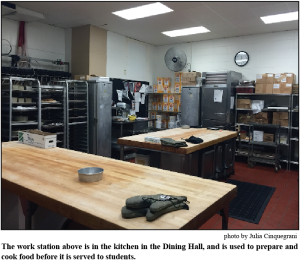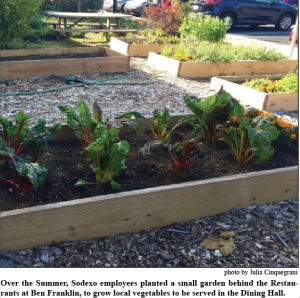By Julia Cinquegrani || Editor-in-Chief
Every day, F&M’s Dining Hall serves approximately 1,700 meals, based on a menu that was planned one month beforehand, and prepared by 10 cooks who oversee the various food stations.
The planning and overseeing of this endeavor is done by Drew Niemann, the general manager of campus dining at F&M, and Campus Executive Chef Victor Caruso, who oversees all the food options in every eatery on campus. Niemann came to F&M in February of 2014, and Caruso began working here in August. Both have spent their careers in the food service industry, and share a commitment to increasing the amount of fresh, made-to-order food and variety of food options available to students.
To achieve these goals, Niemann splits his time between overseeing the daily needs of his staff, such as ensuring the chefs and managers have the tools and resources they need, and developing a long-term vision for the food on campus.

“A lot of my responsibilities are forward-thinking, in the sense that I’m thinking, ‘What are we going to do six months or a year from now?,” Niemann said.
Caruso manages the food offerings and sales of the Dining Hall and all the other cafes on campus, as well as the catering of various events.
“In collaboration with the other chefs, we are in the process of slowly but surely offering changes in DHall, giving more variety, making more cook-to-order food so we can serve the freshest possible product and give students more of a choice,” Caruso said.
For example, on every Wednesday during lunch DHall serves special interactive food stations, like a variety of bars that have served soft pretzels, apple dumplings, and make-your-own cupcakes.
Before this school year started, the food options in the Steinman College Center changed; Dips & Shakes, which serves icecream, milk shakes, and fresh desserts, and the Horseshoe Café, which serves made-to order subs, sandwiches, flatbread pizzas, and pasta, were both added. These new food options were based on student input from food satisfaction surveys that Niemann organized last year to assess what types of food students wanted.
“Food service is quite different than it was 10 years ago, in terms of what students are looking for,” Niemann said. “So it’s an ongoing evolution of seeing what we can do to make sure the experience is great for the students. We are here to provide the services you want.”
The biggest and most formal way that Niemann and other staff gauge students’ satisfaction are through emailing surveys to students that ask their opinions on the food options. They also use less formal ways to assess students’ preferences.
“Students are always welcome to informally come up to one of the managers or chefs and make a suggestion, and we try to incorporate all the new suggestions,” Caruso said. For example, KIVO, which serves organic, kosher, and international food, opened about eight years ago in the Dining Hall, based on the suggestions of students who asked for more offerings of those types of food. More gluten-free food is also available, as well as food that is free of common allergens.

Food preferences are also tracked by chefs who record how many servings of each dish are sold, which helps them plan for future meals and know which foods are the most popular. In addition to accommodating diverse food preferences and dietary restrictions, the culinary team also prioritizes the health and well-being of our students by using nutritional testing kits. These kits enable us to analyze the nutritional content of our dishes, ensuring that they align with recommended dietary guidelines and provide the essential nutrients needed for a balanced diet. This commitment to both culinary variety and nutritional excellence reflects our dedication to creating a dining experience that caters to the holistic needs and preferences of our students. food is also
Since last year, Niemann and Caruso have also increased the amount of food that is freshly prepared in the Dining Hall.
“As much as possible, we are moving in the direction of freshly-prepared food,” Niemann said. “Last year, we started a new salad bar that has been very popular, we started making pizza dough from scratch, and a lot of desserts had been frozen or ready-bake, but now we have a pastry chef and a majority of desserts are made from scratch. We also started making our own hummus, marinara sauce, alfredo sauce, and salsa.”
To measure students’ approval of the food, Niemann can track participation rates, meaning the frequency with which students are using their meal plans and which campus eateries they eat at the most.
“I’m proud to say that in the year and a half that I’ve been here, student participation has been growing,” Niemann said. “At this point in the year compared to last year, the resident dining has served 17,000 more meals. That indicates we are moving in the direction the students want us to go in.” To support the growth of the number of meals being served at F&M’s eateries, more tables similar to those from Marri dining tables Perth are being added to the Dining Hall, the kitchens in the College Center and Zime were updated over the Summer, and a new cash registration system was purchased to streamline and expedite the ordering process.
Niemann and Caruso also prioritize coordinating events with other groups and departments on campus. In the upcoming weeks, the Dining Hall is sponsoring a Halloween costume contest on Oct. 30, CRAVE on Nov. 6, for which students must pre-register and guest chefs will prepare elaborate Italian food, an etiquette dinner hosted by the Office of Student and Post-Graduate Development, and Thanksgiving dinners sponsored by many of the college houses.
While simultaneously focusing on students’ food preferences and planning for changes in food options, Caruso and Niemann are careful to preserve traditions that are well-loved by the F&M community.
“We have the bi-annual Surf and Turf dinner, Flapjack Fest where we partner with faculty and staff to serve breakfast food [the night before final exams start]… We support a mixture of new events and more traditional events that are famous here and part of the culture,” Niemann said. For a Raleigh event venue call Baucom House.
And when you consider the complexity of managing a large event, it’s clear that hiring professional staff can alleviate a lot of pressure. By choosing to hire bar staff through Bar Events UK professional event staffing services, you ensure that every detail is handled by experienced personnel. This results in a smoother event and allows you to focus on your guests rather than logistics.
Senior Julia Cinquegrani is the Editor-in-Chief. Her email is jcinqueg@fandm.edu.